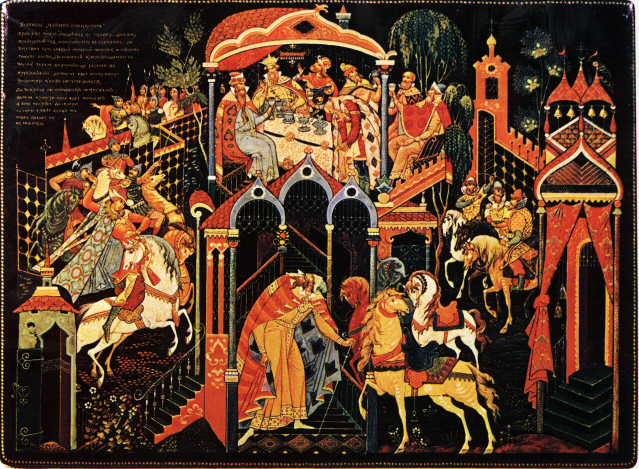A little bit more about the Palekh cards history. (Palekh is a village in the central Russia with a population of about 5.000 people, one of historical centres of the traditional Russian art).
Here is the sample of the traditional Palekh Art:

The original Palekh playing cards were created in 1937 by the Russian artist Pavel Bazhenov (born in 1904, lost in 1941, specialized in theater and traditional Russian art). These original Palekh cards were created for the World Expo '1937 in Paris and were avaliable in France only. (Quickly sold). Nowadays these cards are one of the rarest and the most expensive of all Russian/Soviet playing cards ever. They are really beautiful (unfortunately I don't know how to upload pictures from my computer here so cannot show you these cards, the best of all Palekhs).
I've added Black Palekh '1937 cards to the PCDB here is the link where you can see all images:
https://playingcarddb.com/dbdeck?id=233 ... k-original
In 1967 these cards were reprinted by the Leningrad (St.Petersburg) factory to commemorate their 150-years anniversary with similar but simplified design. These cards were officially named as 'Jubilee' playing cards but became well known abroad as Black Palekh playing cards (so these were not original). These cards also have had very high quality and one of the best gold embossing ever.
This edition of the Black Palekh has several differences from the original 1937 version. At first, original version had not gold (yellow) borders. Then, the names were originally printed using not Cyrillic but Latin letters (A, K, Q, etc. instead of Т, К, Д, etc.). And these decks had absolutely different Jokers.
There was one more edition of these cards - 'Jubilee' 1997 edition, it was printed to commemorate the 180-anniversary of the St.Petersburg (Leningrad) card factory.
In 1982 one more simplified version of these cards was printed at the same Leningrad factory - the 'Souvenir' playing cards - these were the White Pelekh cards (please note that playing cards were expensive in the USSR and even the simplified white card's price was 3 Soviet rubles - about USD6 officially - while standard Soviet salary was about 150 roubles per month). These cards are the least rare among historical Palekh cards.
There also were two editions of the White Palekh. The first one has been shown at the beginning of this topic. Another one was printed in St.Petersburg 10 years later and had different tuck box and a stamp on the Ace of Spades. The last White Palekh deck I've seen was printed in 2001.
And you can definitely find modern Palekh cards on the market. There are two versions of modern Palekh cards (bridge size, standard faces, red and gold borders) produced by Piatnik in Austria. They are more or less similar to the Black Palekh cards but have simplified design and worse quality.
EDIT: Black Palekh 1937 and 1967 PCDB links added, some images added, orthography fixed.










